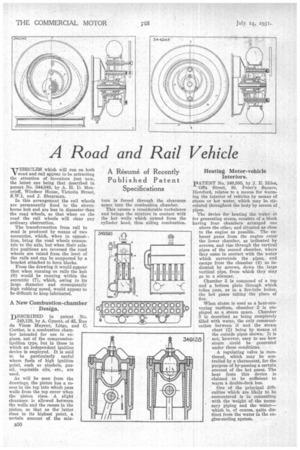A Road and Rail Vehicle
Page 68

If you've noticed an error in this article please click here to report it so we can fix it.
A Resume of Recently Published Patent Specifications
TEHICLDS which will run on both
V road and rail appear to be attracting the attention of inventors just now, the latest one being that described in patent No. 344,048, by A. H. a Moncrieff, Windsor House,.-Victoria Street, S.W.1, and J. Shearman.
In this arrangement the rail wheels are permanently fixed to the sleeveborne hub and are less in diameter than the road wheels, so that when on the road the rail wheels will clear any ordinary obstruction.
The transformation from rail to road is produced by means of two eccentrics, which, when in opposi-. ton, bring the road wheels concentric to the axle, but when their relative positions are reversed the road wheels are raised from the level of the rails and can be supported by a bracket attached to horn blocks.
From the drawing it would appear that when running on rails the hub ,(6) would be running within the eccentric (7), Which, owing to its large diameter and consequently high rubbing speed, would appear to be difficult to keep lubricated.
A New Combustion-chamber Design.
DESCRIBED in patent No.
349,128, by A. Gysens, of 45, Rue du Vieur Mayeur, Liege, and C Cortier, is a combustion chamber intended for use in engines, not of the compressionignition type, but in those in which an independent ignition device is employed. It is said to be particularly useful where fuels of high ignition paint, such as alcohols, gasoil, vegetable oils, etc., are used.
As will be seen from the drawings, the piston has a recess in the top into which pass walls from the top cover when the piston rises. A slight clearance is allowed between the walls and the recess in the piston, so that as the latter rises to its highest point, a certain amount of the mix tare is forced through the clearance space into the combustion chamber.
This causes a considerable turbulence and brings the mixture in contact with the hot walls which extend from the cylinder head, thus aiding combustion. Heating Motor-vehicle Interiors.
PATENT No. 340,505, by J. E. Hiles, Offa Street, St. Peter's Square, Hereford, relates to a means for warming the interior of vehicles by means of steam or hot water, which may be circulated throughout the body by means of pipes.
The device for heating the water or for generating steam, consists of a block having four chambers arranged one above the other, and situated as close to the engine as possible. The exhaust gases from the engine enter the lower chamber, as indicated by arrows, and rise through the vertical pipes of the second chamber, -where they come in contact with the water which surrounds the pipes, and escape from the chamber (4) as indicated by arrows, down the large vertical pipe, from which they may go to a silencer.
Chamber 3 is composed of a top and a bottom plate through which tubes pass, as in a fire-tube boiler, the hot gases taking the place of fire.
When steam is used as a heat-conveying medium, chamber 2 is employed as a steam space. Chamber 3 is described as being completely filled with water, the only.communica ion .between it and the steam chest (2) being by Means of the outside pipes shown.It is not; however, easy to see how steam could be generated under these conditions.
A regulating valve is mentioned, which may be controlled by a thermostat, for the purpose of by-passing a certain amount of the hot gases. The heat from this device is claimed to be sufficient to warm a double-deck bus.
One of the principal difficulties which are likely to be encountered is in connection with the weight of the necessary piping and the water— which is, of course, quite distinct from the water in the engine-cooling system.




































































































